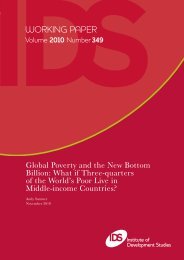IDS WORKING PAPER - Institute of Development Studies
IDS WORKING PAPER - Institute of Development Studies
IDS WORKING PAPER - Institute of Development Studies
Create successful ePaper yourself
Turn your PDF publications into a flip-book with our unique Google optimized e-Paper software.
government to set legally binding emission reduction targets and to reduce GHG emissions.<br />
USCAP published its ‘Blueprint for Legislative Action’ in 2007 which calls for ‘prompt<br />
enactment <strong>of</strong> national legislation in the United States to slow, stop and reverse the growth<br />
<strong>of</strong> greenhouse gas (GHG) emissions over the shortest time reasonably achievable’ (USCAP<br />
2007: 1). In its policies, the organisation calls for an emission reduction <strong>of</strong> 80 per cent by<br />
2050, meaning that the US economy should only emit 20 per cent <strong>of</strong> its 2005 emissions. To<br />
achieve these targets, the organisation suggests introducing a national cap-and-trade<br />
system, fostering innovation such as Carbon Capture and Storage (CCS) and advocates for<br />
low carbon and energy efficient technology for transport and buildings (USCAP 2007).<br />
Nevertheless one could argue that this system lacks stringency as it is only based on s<strong>of</strong>t<br />
laws, does not provide enforcement mechanisms and there is a high risk <strong>of</strong> free-riding for<br />
companies outside <strong>of</strong> the USCAP association.<br />
According to Business and the Environment (2009), the US corporations Levi Strauss, Nike,<br />
Starbucks, Sun Microsystems and The Timberland Company joined with the Coalition for<br />
Environmentally Responsible Economies (CERES) in 2008 to develop a new business<br />
alliance. This business alliance has the aim to influence the development <strong>of</strong> a strong US<br />
climate and energy policy to achieve a low carbon economy. The new alliance is called<br />
Business for Innovative Climate and Energy Policy (BICEP). The initiative has ambitious<br />
GHG emission targets: 25 per cent GHG reduction by 2020 below 1990 levels and 80 per<br />
cent GHG reduction by 2050 below 1990 levels, establish an US emission trading system,<br />
increase energy efficiency by 200 per cent, promote fuel-efficient vehicles, increase<br />
investments in low carbon energy and energy efficient technology, promote green jobs,<br />
introduce a renewable standard which means that all electricity generated must come from<br />
at least 20 per cent <strong>of</strong> renewable energy sources by 2020 and 30 per cent by 2030, and<br />
‘limit the construction <strong>of</strong> new coal-fired power plants to those that capture and store carbon<br />
emissions’ (Business and the Environment 2009: 14–15). These targets are not only<br />
ambitious, but also exceed the climate and energy policies that most states currently have<br />
in place. Leading US corporations are here the drivers <strong>of</strong> radical climate change mitigation<br />
policy. This is not only driven by the desire to increase these corporations’ reputation or to<br />
develop a good Corporate Social Responsibility (CSR) policy, but by the belief that a<br />
fundamental change <strong>of</strong> the system is needed and that this cannot be achieved by the state<br />
alone. Lobbying plays an important part <strong>of</strong> this process. Lobbying by corporations in the<br />
climate change arena is however nothing new. Oil ‘giants’ such as Exxon Mobile have been<br />
known in the past to ‘argue against business responsibility for global warming’, however<br />
‘competitors such as BP or Shell more recently have come to the conclusion that there is a<br />
moral responsibility for business to engage in GHG emission reduction’ (Levy 2005 in:<br />
Eberlein and Matten 2009: 244). Interestingly, the BICEP case study might have turned the<br />
tables by lobbying for strict climate and energy policy instead <strong>of</strong> against it. In this case,<br />
business ethics form a surrogate regulation and have the long-term aim to contribute<br />
towards legislation.<br />
Nevertheless while these are powerful aspirations, the effect at the national level remains to<br />
be seen. The above mentioned approaches seem to be fragmented with a lack <strong>of</strong> cohesion<br />
among different firms, associations <strong>of</strong> firms and industries. Free-riding, the lack <strong>of</strong><br />
enforcement mechanisms, the risk <strong>of</strong> green-washing to improve business reputations and<br />
sometimes low impacts on national emissions pose major challenges.<br />
2.3 Case study 3: Malaysia – climate change mitigation efforts are both equally<br />
state-driven and corporation-driven<br />
The third case study relates to climate change mitigation in Malaysia, with specific reference<br />
to its large tropical forests and the bi<strong>of</strong>uel industry. We present this case study because it is<br />
an example <strong>of</strong> how business and states are dealing with climate change mitigation in<br />
Malaysia.<br />
12

















